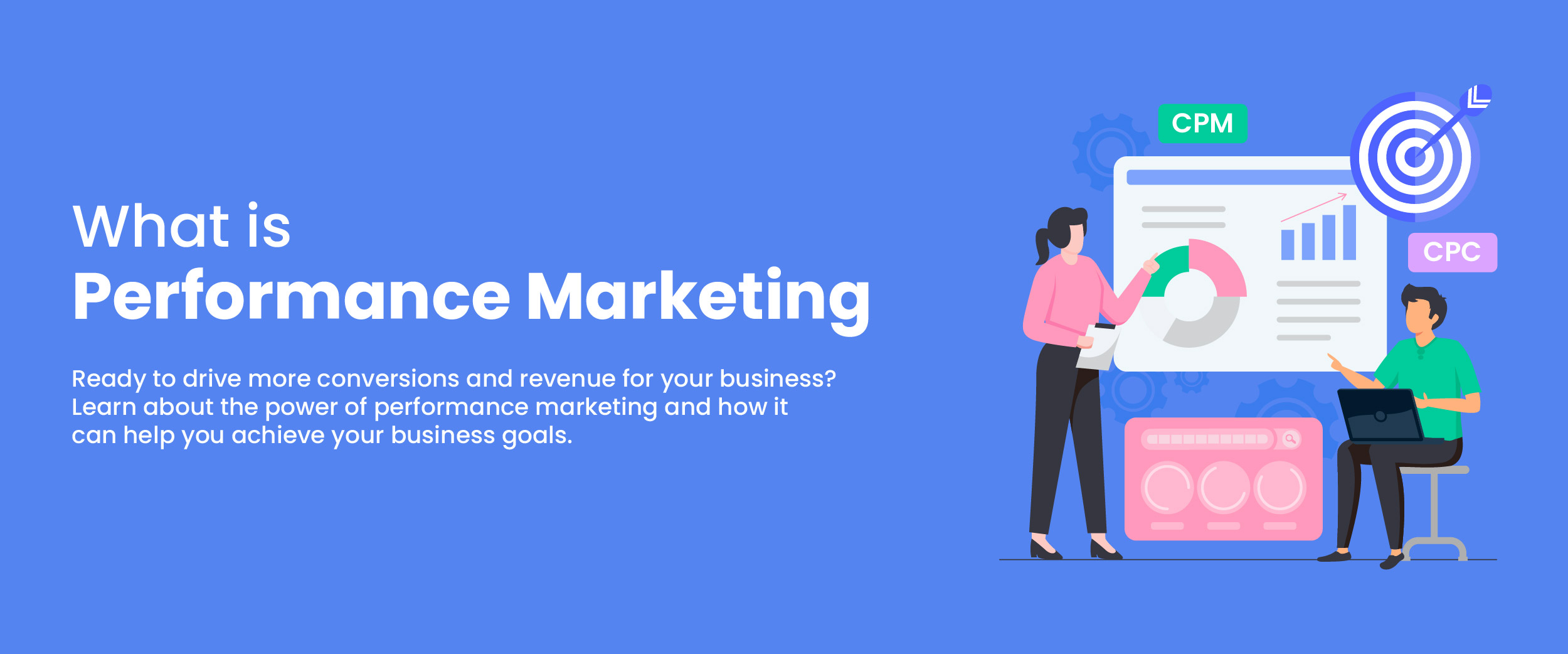What is Performance Marketing?
Performance marketing is one of the types of digital marketing that seeks measurable outcomes such as clicks, conversions, or sales. It has its roots in the early days of the Internet when banner ads and affiliate marketing were the primary methods of driving traffic and sales.
New forms of performance marketing emerged as the internet and digital advertising evolved. By bidding on keywords and targeting specific audiences, search engine marketing (SEM) became a popular way to drive traffic and sales.
It is one of the major tactics in digital marketing. Advertisers only receive payment, when particular events take place. For instance, when a viewer clicks through to their page or purchases anything.
Let’s learn more about what is performance marketing in digital marketing, how it works, its benefits, top channels, and the metrics used.
Performance Marketing- An Overview
A creative and effective strategy to increase your audience and reach while simultaneously obtaining crucial data is performance marketing. It is the practice of brands only paying marketing service providers when their objectives have been met or when particular activities, like a click, sale, or lead, have been completed.
The key benefit is the ability to measure performance and track the success of each campaign and also allows advertisers to make changes to their campaigns in real time and increase their effectiveness. One can become an expert in performance marketing by learning the details of digital marketing from the available digital marketing courses.
To build and run adverts for their business on any number of performance marketing channels, including social media, search engines, videos, embedded web content, and more, advertisers must connect with publishers or agencies. Instead of paying for advertisements in the traditional sense, these advertisers pay according to how well their ads perform as indicated by the number of clicks, impressions, shares, or transactions.
How Does Performance Marketing Work?
The specifics may differ based on the ad network or platform being used, but these phases give a general overview of the process –
- Define Campaign Goals: The first step is to define the specific goals of the campaign. For example, the goal might be to generate leads, increase sales, or drive website traffic.
- Choose a Performance Marketing Channel: Once the campaign goals are defined, the next step is to choose a performance marketing channel that aligns with those goals. Some common channels include search engine marketing, social media marketing, email marketing, affiliate marketing, and display advertising.
- Create and Launch the Campaign: Once the channel is chosen, the next step is to create and launch the campaign. This involves creating ad creative, targeting specific audiences, and setting a budget.
- Measure and Optimize Performance: As the campaign runs, performance metrics such as click-through rate, conversion rate, and cost per acquisition are tracked and analyzed. Based on this data, the campaign is optimized to improve performance and achieve the campaign goals.
- Pay for Performance: Unlike traditional advertising where businesses pay for ad impressions, in performance marketing, businesses only pay for specific actions that the user takes, such as clicking on an ad, filling out a form, or making a purchase.
- Repeat and Scale: Once a campaign is successful, it can be repeated and scaled to reach a larger audience and achieve even better results.
Explore the best digital marketing placement guarantee course to master all the concepts of digital marketing.
Different Ways to Pay for Performance Marketing
Advertisers place their ads on certain channels, and they are paid according to how well the ad does. When it comes to performance marketing, there are a few different payment options:
Cost Per Click (CPC)
In the CPC model, the advertisers are paid when someone clicks on their ads. This helps in increasing the traffic to a website.
Cost Per Impression (CPM)
CPM are the views of your ads. For example – If 30000 people watch your ad, you would pay your base rate multiplied by 30 under the CPM model.
Cost Per Sale (CPS)
You only pay with CPS when an ad generates revenue (sale). The CPS model is commonly used in affiliate marketing.
Cost Per Lead (CPL)
The CPL model is similar to CPS, the CPL model helps in generating leads and it charges the advertiser when someone registers for an event like a webinar or a newsletter.
Cost per acquisition (CPA)
Under this model when a customer takes any action such as purchasing, sharing their information, visiting your website, etc., then the advertisers get paid.
Top Performance Marketing Channels
Here is a list of some popular performance marketing channels:
Search Engine Marketing (SEM):
This includes paid search advertising and search engine optimization (SEO) to drive traffic and generate leads from search engines like Google and Bing.
Social Media Marketing (SMM)
This includes social media advertising on platforms like Facebook, Instagram, Twitter, and LinkedIn, as well as social media management. Social media marketing is used to increase brand awareness and engagement.
Email Marketing
Promotional messages or newsletters are sent to a list of subscribers using email marketing strategies who have opted-in to receive them.
Affiliate Marketing:
Affiliate marketing involves partnering with affiliates who promote your products or services and receive a commission for each sale or lead they generate. Affiliate marketing
Display Advertising
This includes banner ads, pop-up ads, and other visual ads on websites, blogs, and mobile apps.
Content Marketing:
The process of content marketing includes creating and sharing valuable content, such as blog posts, videos, and infographics, to attract and engage potential customers
Video Marketing:
This involves sharing and editing videos on platforms like YouTube, Vimeo, and Facebook to promote your products or services.
Influencer Marketing
Influncer marketing involves collaborating with social media influencers who have a sizable following to promote your business and goods.
Retargeting/Remarketing
This involves targeting people who have previously interacted with your website or ads with relevant ads to encourage them to complete a desired action.
Mobile Marketing
Mobile marketing includes advertising on mobile apps, mobile websites, and mobile games to reach audiences on their mobile devices.


Metrics of Performance Marketing
To measure the success of campaigns, businesses use a variety of metrics. Here are some common metrics:
Click-Through Rate (CTR)
The percentage of people who clicked on an ad compared to the total number of people who saw the ad.
Conversion Rate (CR):
The percentage of people who completed a desired action, such as making a purchase or filling out a form, compared to the total number of people who clicked on an ad.
Cost Per Click (CPC):
The cost of each click on an ad.
Cost Per Acquisition (CPA):
The cost of acquiring a new customer or lead.
Return on Investment (ROI):
The ratio of the revenue generated from a campaign to the cost of the campaign.
Customer Lifetime Value (CLV):
The total value of a customer throughout their relationship with a business.
Engagement Rate:
The percentage of people who interact with an ad, such as liking, sharing, or commenting, compared to the total number of people who saw the ad.
Impressions:
The number of times an ad was seen by potential customers.
Revenue:
The total amount of money generated from a campaign.
Bounce Rate:
The percentage of people who leave a website after viewing only one page
Benefits of Performance Marketing
This branch of marketing has several benefits for businesses, including:
Cost-Effectiveness:
With performance marketing, businesses only pay for specific actions, such as clicks, leads, or sales, rather than for ad impressions. This makes it more cost-effective than traditional advertising.
Measurable Results:
It is highly measurable, with detailed analytics and performance metrics available to track and optimize campaigns. This allows businesses to see the exact results of their campaigns and make data-driven decisions to improve performance.
Targeted Audience:
It allows businesses to target specific audiences based on demographics, interests, behaviors, and other factors. This ensures that the right message is delivered to the right people at the right time, improving the effectiveness of the campaign.
Flexibility:
All the campaigns can be customized and optimized in real-time based on the performance data. This allows businesses to adjust their strategies as needed to achieve the best results.
Increased ROI:
Campaigns can provide a high return on investment (ROI) since businesses only pay for specific actions that lead to a desired outcome, such as a sale or lead.
Brand Awareness:
While the primary goal of performance marketing is to drive specific actions, such as clicks or sales, it can also improve brand awareness and increase the visibility of a business.
Overall, performance marketing provides businesses with a highly effective and cost-efficient way to reach and engage with their target audience, drive specific actions, and achieve their marketing goals.
Conclusion
Using performance marketing channels can help you scale your advertising efforts to suit the needs of your organization without breaking the bank, especially as the future of digital marketing becomes more promising every year.







